Analysis of the Long-Term Variability of Poor Visibility Events in the UAE and the Link with Climate Dynamics
Abstract
:1. Introduction
2. Data and Method
2.1. Study Domain
2.2. Datasets
2.3. Methods
3. Results and Discussion
3.1. Analysis of Raw Visibility Data
3.2. Long-Term Visibility Variability and Trend Analysis
3.3. Frequency Analysis of Wet- and Dry-Related Poor Visibility Events
3.4. Links with Climate Dynamics
3.4.1. Fog and Climate Oscillations
3.4.2. Dust and Climate Oscillations
4. Conclusions
Acknowledgments
Author Contributions
Conflicts of Interest
Appendix A. Description of Statistical Methods Used
References
- Luo, C.-H.; Yuan, C.-S.; Wen, C.-Y.; Liaw, J.-J.; Chiu, S.-H. Investigation of urban atmospheric visibility using Haar wavelet transform. Aerosol Air Qual. Res. 2005, 5, 39–47. [Google Scholar]
- Che, H.; Zhang, X.; Li, Y.; Zhou, Z.; Qu, J.J. Horizontal visibility trends in China 1981–2005. Geophys. Res. Lett. 2007, 34. [Google Scholar] [CrossRef]
- Chen, Y.; Xie, S.-D. Long-term trends and characteristics of visibility in two megacities in southwest China: Chengdu and Chongqing. J. Air Waste Manag. Assoc. 2013, 63, 1058–1069. [Google Scholar] [CrossRef] [PubMed]
- Yang, L.-X.; Wang, D.-C.; Cheng, S.-H.; Wang, Z.; Zhou, Y.; Zhou, X.-H.; Wang, W.-X. Influence of meteorological conditions and particulate matter on visual range impairment in Jinan, China. Sci. Total Environ. 2007, 383, 164–173. [Google Scholar] [CrossRef] [PubMed]
- Appel, B.; Tokiwa, Y.; Hsu, J.; Kothny, E.; Hahn, E. Visibility as related to atmospheric aerosol constituents. Atmos. Environ. 1985, 19, 1525–1534. [Google Scholar] [CrossRef]
- Malm, W. Considerations in the measurement of visibility. J. Air Pollut. Control Assoc. 1979, 29, 1042–1052. [Google Scholar] [CrossRef]
- Smirnova, T.G.; Benjamin, S.G.; Brown, J.M. Case study verification of RUC/MAPS fog and visibility forecasts. In Proceedings of the 9th Conference on Aviation, Range, and Aerospace Meteorology, Orlando, FL, USA, 11–15 September 2000; pp. 31–36. [Google Scholar]
- Sabetghadam, S.; Ahmadi-Givi, F.; Golestani, Y. Visibility trends in Tehran during 1958–2008. Atmos. Environ. 2012, 62, 512–520. [Google Scholar] [CrossRef]
- Abdelfatah, A.S.; Marzouk, M.; Garib, A.; Al-Harthei, H. A framework for Abu Dhabi police traffic monitoring and response center. J. Traffic Logist. Eng. 2013, 1, 243–248. [Google Scholar] [CrossRef]
- Al-Harthei, H.; Ben Ali, O.; Garib, A. Real-time traffic patrol allocation for Abu Dhabi emirate (UAE). J. Traffic Logist. Eng. 2013, 1, 64–68. [Google Scholar] [CrossRef]
- Funk, W.E.; Pleil, J.D.; Pedit, J.A.; Boundy, M.G.; Yeatts, K.B.; Nash, D.G.; Trent, C.B.; El Sadig, M.; Davidson, C.A.; Leith, D. Indoor air quality in the United Arab Emirates. J. Environ. Prot. 2014, 5, 709. [Google Scholar] [CrossRef]
- Balarabe, M.; Abdullah, K.; Nawawi, M. Long-Term Trend and Seasonal Variability of Horizontal Visibility in Nigerian Troposphere. Atmosphere 2015, 6, 1462–1486. [Google Scholar] [CrossRef]
- Lin, M.; Tao, J.; Chan, C.-Y.; Cao, J.-J.; Zhang, Z.-S.; Zhu, L.-H.; Zhang, R.-J. Regression analyses between recent air quality and visibility changes in megacities at four haze regions in China. Aerosol Air Qual. Res. 2012, 12, 1049–1061. [Google Scholar] [CrossRef]
- Xiao, S.; Wang, Q.; Cao, J.; Huang, R.-J.; Chen, W.; Han, Y.; Xu, H.; Liu, S.; Zhou, Y.; Wang, P. Long-term trends in visibility and impacts of aerosol composition on visibility impairment in Baoji, China. Atmos. Res. 2014, 149, 88–95. [Google Scholar] [CrossRef]
- Pui, D.Y.; Chen, S.-C.; Zuo, Z. PM2.5 in China: Measurements, sources, visibility and health effects, and mitigation. Particuology 2014, 13, 1–26. [Google Scholar] [CrossRef]
- Jaswal, A.K.; Kumar, N.; Prasad, A.K.; Kafatos, M. Decline in horizontal surface visibility over India (1961–2008) and its association with meteorological variables. Natl. Hazards 2013, 68, 929–954. [Google Scholar] [CrossRef]
- Doyle, M.; Dorling, S. Visibility trends in the UK 1950–1997. Atmos. Environ. 2002, 36, 3161–3172. [Google Scholar] [CrossRef]
- Xiao, Z.-M.; Zhang, Y.-F.; Hong, S.-M.; Bi, X.-H.; Jiao, L.; Feng, Y.-C.; Wang, Y.-Q. Estimation of the main factors influencing haze, based on a long-term monitoring campaign in Hangzhou, China. Aerosol Air Qual. Res. 2011, 11, 873–882. [Google Scholar] [CrossRef]
- Sloane, C.S. Visibility trends—I. Methods of analysis. Atmos. Environ. 1982, 16, 41–51. [Google Scholar] [CrossRef]
- Lee, H.-H.; Bar-Or, R.Z.; Wang, C. Biomass burning aerosols and the low-visibility events in Southeast Asia. Atmos. Chem. Phys. 2017, 17, 965–980. [Google Scholar] [CrossRef]
- Tiwari, S.; Payra, S.; Mohan, M.; Verma, S.; Bisht, D.S. Visibility degradation during foggy period due to anthropogenic urban aerosol at Delhi, India. Atmos. Pollut. Res. 2011, 2, 116–120. [Google Scholar] [CrossRef]
- Al Senafi, F.; Anis, A. Shamals and climate variability in the Northern Arabian/Persian Gulf from 1973 to 2012. Int. J. Climatol. 2015, 35, 4509–4528. [Google Scholar] [CrossRef]
- Mathai, C.; Tombach, I. A critical assessment of atmospheric visibility and aerosol measurements in the eastern United States. JAPCA 1987, 37, 700–707. [Google Scholar] [CrossRef]
- Singh, A.; Bloss, W.J.; Pope, F.D. 60 years of UK visibility measurements: Impact of meteorology and atmospheric pollutants on visibility. Atmos. Chem. Phys. 2017, 17, 2085–2101. [Google Scholar] [CrossRef]
- Luo, C.-H.; Wen, C.-Y.; Yuan, C.-S.; Liaw, J.-J.; Lo, C.-C.; Chiu, S.-H. Investigation of urban atmospheric visibility by high-frequency extraction: Model development and field test. Atmos. Environ. 2005, 39, 2545–2552. [Google Scholar] [CrossRef]
- Abdi Vishkaee, F.; Flamant, C.; Cuesta, J.; Oolman, L.; Flamant, P.; Khalesifard, H.R. Dust transport over Iraq and northwest Iran associated with winter Shamal: A case study. J. Geophys. Res. Atmos. 2012, 117. [Google Scholar] [CrossRef] [Green Version]
- Gultepe, I.; Pearson, G.; Milbrandt, J.; Hansen, B.; Platnick, S.; Taylor, P.; Gordon, M.; Oakley, J.; Cober, S. The fog remote sensing and modeling field project. Bull. Am. Meteorol. Soc. 2009, 90, 341. [Google Scholar] [CrossRef]
- Norouzi, H.; Temimi, M.; Prigent, C.; Turk, J.; Khanbilvardi, R.; Tian, Y.; Furuzawa, F.; Masunaga, H. Assessment of the consistency among global microwave land surface emissivity products. Atmos. Meas. Tech. 2015, 8, 1197. [Google Scholar] [CrossRef]
- Norouzi, H.; Temimi, M.; AghaKouchak, A.; Azarderakhsh, M.; Khanbilvardi, R.; Shields, G.; Tesfagiorgis, K. Inferring land surface parameters from the diurnal variability of microwave and infrared temperatures. Phys. Chem. Earth Parts A/B/C 2015, 83, 28–35. [Google Scholar] [CrossRef]
- Al Azhar, M.; Temimi, M.; Zhao, J.; Ghedira, H. Modeling of circulation in the Arabian Gulf and the Sea of Oman: Skill assessment and seasonal thermohaline structure. J. Geophys. Res. Oceans 2016, 121, 1700–1720. [Google Scholar] [CrossRef]
- Chaouch, N.; Temimi, M.; Weston, M.; Ghedira, H. Sensitivity of the meteorological model WRF-ARW to planetary boundary layer schemes during fog conditions in a coastal arid region. Atmos. Res. 2017, 187, 106–127. [Google Scholar] [CrossRef]
- McMurry, P.H.; Stolzenburg, M.R. On the sensitivity of particle size to relative humidity for Los Angeles aerosols. Atmos. Environ. 1989, 23, 497–507. [Google Scholar] [CrossRef]
- Filonczuk, M.K.; Cayan, D.R.; Riddle, L.G. Variability of Marine Fog along the California Coast; Scripps Institution of Oceanography: La Jolla, CA, USA, 1995. [Google Scholar]
- Environment Agency Abu Dhabi, E.A.A.D. Climate Change Impacts, Vulnerability & Adaptation; Report; Environment Agency Abu Dhabi: Abu Dhabi, UAE, 2009.
- Kazim, A.M. Assessments of primary energy consumption and its environmental consequences in the United Arab Emirates. Renew. Sustain. Energy Rev. 2007, 11, 426–446. [Google Scholar] [CrossRef]
- Worldometers. United Arab Emirates Population. Available online: http://www.worldometers.info/world-population/united-arab-emirates-population/ (accessed on 10 September 2017).
- NCEI, N.C.f.E.I. NOAA’s U.S. Integrated Surface Global Hourly Data. NCEI DSI 3505. gov.noaa.ncdc:C00532, 1982–2016. Available online: https://www.esrl.noaa.gov (accessed on 17 January 2017).
- Tan, J.; Duan, J.; He, K.; Ma, Y.; Duan, F.; Chen, Y.; Fu, J. Chemical characteristics of PM2.5 during a typical haze episode in Guangzhou. J. Environ. Sci. 2009, 21, 774–781. [Google Scholar] [CrossRef]
- Lawrence, M.G. The relationship between relative humidity and the dewpoint temperature in moist air: A simple conversion and applications. Bull. Am. Meteorol. Soc. 2005, 86, 225–233. [Google Scholar] [CrossRef]
- Department of the Air Force. Aircrew Quick Reference to the METAR and TAF Codes. Air Force Pamphlet 11-238, 2005. Available online: http://www.e-publishing.af.mil (accessed on 1 November 2005).
- Yue, S.; Wang, C. The Mann-Kendall test modified by effective sample size to detect trend in serially correlated hydrological series. Water Resour. Manag. 2004, 18, 201–218. [Google Scholar] [CrossRef]
- Miller, S.D.; Kuciauskas, A.P.; Liu, M.; Ji, Q.; Reid, J.S.; Breed, D.W.; Walker, A.L.; Mandoos, A.A. Haboob dust storms of the southern Arabian Peninsula. J. Geophys. Res. Atmos. 2008, 113. [Google Scholar] [CrossRef]
- Shahid, S.A.; Abdelfattah, M.A. Soils of Abu Dhabi Emirate. In Terrestrial Environment of Abu Dhabi Emirate; Environment Agency: Abu Dhabi, UAE, 2008; pp. 71–91. [Google Scholar]
- National Center of Meteorlogoy and Seismology. Dust—United Arab Emirates 2001–2011; A National Report; National Center of Meteorlogoy and Seismology: Abu Dhabi, UAE, 2011.
- Kalnay, E.; Kanamitsu, M.; Kistler, R.; Collins, W.; Deaven, D.; Gandin, L.; Iredell, M.; Saha, S.; White, G.; Woollen, J. The NCEP/NCAR 40-year reanalysis project. Bull. Am. Meteorol. Soc. 1996, 77, 437–471. [Google Scholar] [CrossRef]
- Eager, R.E.; Raman, S.; Wootten, A.; Westphal, D.L.; Reid, J.S.; Al Mandoos, A. A climatological study of the sea and land breezes in the Arabian Gulf region. J. Geophys. Res. Atmos. 2008, 113, D15. [Google Scholar] [CrossRef]
- Hamza, W.; Enan, M.R.; Al-Hassini, H.; Stuut, J.-B.; de-Beer, D. Dust storms over the Arabian Gulf: a possible indicator of climate changes consequences. Aquat. Ecosyst. Health Manag. 2011, 14, 260–268. [Google Scholar] [CrossRef]
- Naizghi, M.S.; Ouarda, T.B.M.J. Teleconnections and analysis of long-term wind speed variability in the UAE. Int. J. Climatol. 2016. [Google Scholar] [CrossRef]
- De Villiers, M.; Van Heerden, J. Fog at Abu Dhabi international airport. Weather 2007, 62, 209–214. [Google Scholar] [CrossRef]
- Syed, F.S.; Körnich, H.; Tjernström, M. On the fog variability over south Asia. Clim. Dyn. 2012, 39, 2993–3005. [Google Scholar] [CrossRef]
- Ouarda, T.; Charron, C.; Kumar, K.N.; Marpu, P.; Ghedira, H.; Molini, A.; Khayal, I. Evolution of the rainfall regime in the United Arab Emirates. J. Hydrol. 2014, 514, 258–270. [Google Scholar] [CrossRef]
- Zhang, S.-P.; Xie, S.-P.; Liu, Q.-Y.; Yang, Y.-Q.; Wang, X.-G.; Ren, Z.-P. Seasonal variations of yellow sea fog: Observations and mechanisms. J. Clim. 2009, 22, 6758–6772. [Google Scholar] [CrossRef]
- Cao, Z.; Sheng, L.; Liu, Q.; Yao, X.; Wang, W. Interannual increase of regional haze-fog in North China Plain in summer by intensified easterly winds and orographic forcing. Atmos. Environ. 2015, 122, 154–162. [Google Scholar] [CrossRef]
- Qu, W.; Wang, J.; Zhang, X.; Yang, Z.; Gao, S. Effect of cold wave on winter visibility over eastern China. J. Geophys. Res. Atmos. 2015, 120, 2394–2406. [Google Scholar] [CrossRef]
- NCEP. El Niño and La Niña Years and Intensities Based on Oceanic Niño Index (ONI). Updated September 2017. Available online: http://www.cpc.necp.noaa.gov/products/analysis_monitoring/ensostuff/ensoyears/shtml (accessed on 15 August 2017).
- Deser, C.; Blackmon, M.L. On the relationship between tropical and North Pacific sea surface temperature variations. J. Clim. 1995, 8, 1677–1680. [Google Scholar] [CrossRef]
- Woodall, W.H.; Ncube, M.M. Multivariate cusum quality-control procedures. Technometrics 1985, 27, 285–292. [Google Scholar] [CrossRef]
- Xue, J.H.; Titterington, D.M. t-Tests, F-tests and Otsu’s Methods for Image Thresholding. IEEE Trans. Image Process. 2011, 20, 2392–2396. [Google Scholar] [PubMed]
- Pallmann, P.; Hothorn, L.A.; Djira, G.D. A Levene-type test of homogeneity of variances against ordered alternatives. Comput. Stat. 2014, 29, 1593–1608. [Google Scholar] [CrossRef]
- Schultz, B.B. Levene’s test for relative variation. Syst. Biol. 1985, 34, 449–456. [Google Scholar] [CrossRef]
- O’Neill, M.E.; Mathews, K.L. Levene Tests of Homogeneity of Variance for General Block and Treatment Designs. Biometrics 2002, 58, 216–224. [Google Scholar] [CrossRef] [PubMed]
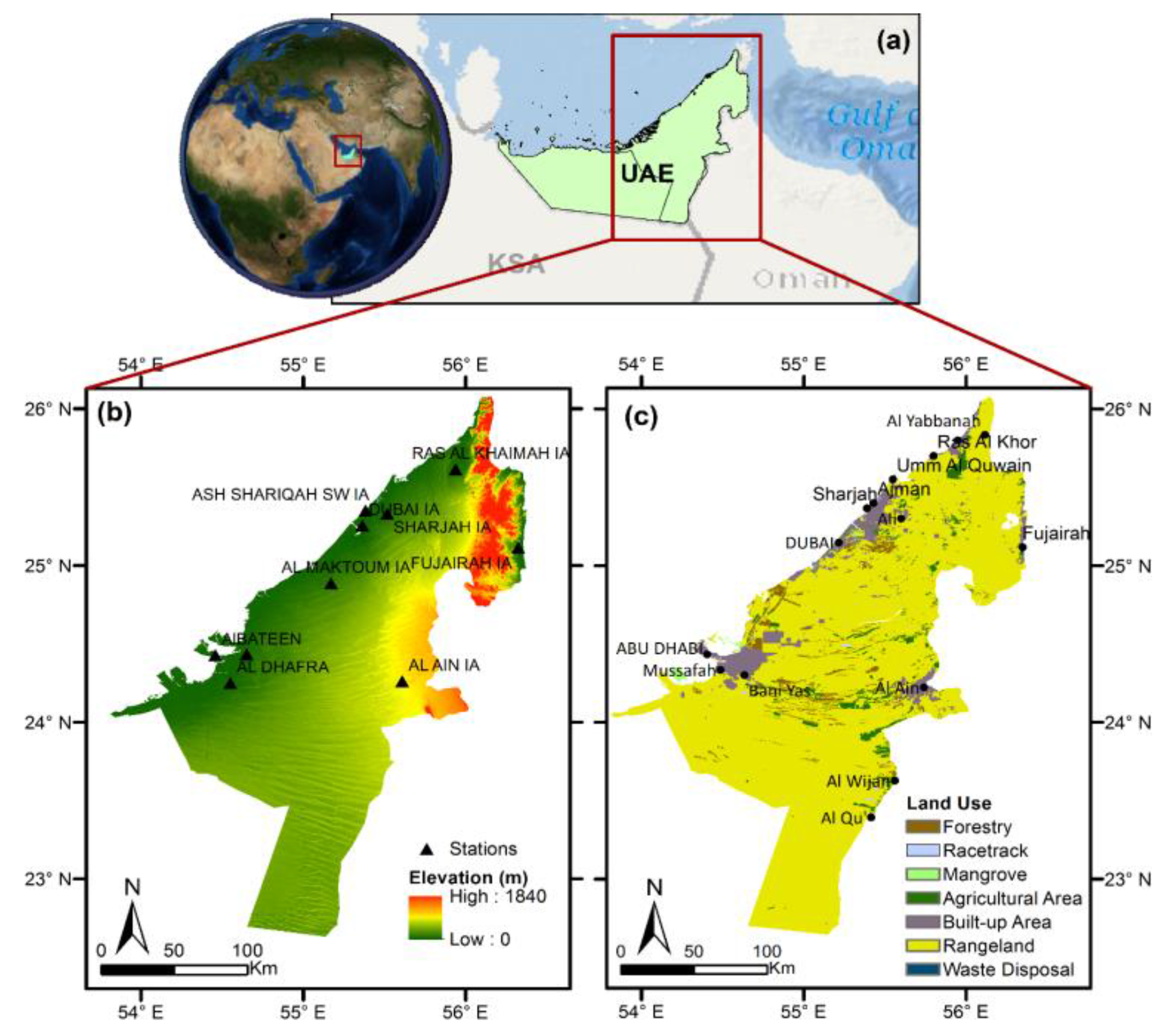

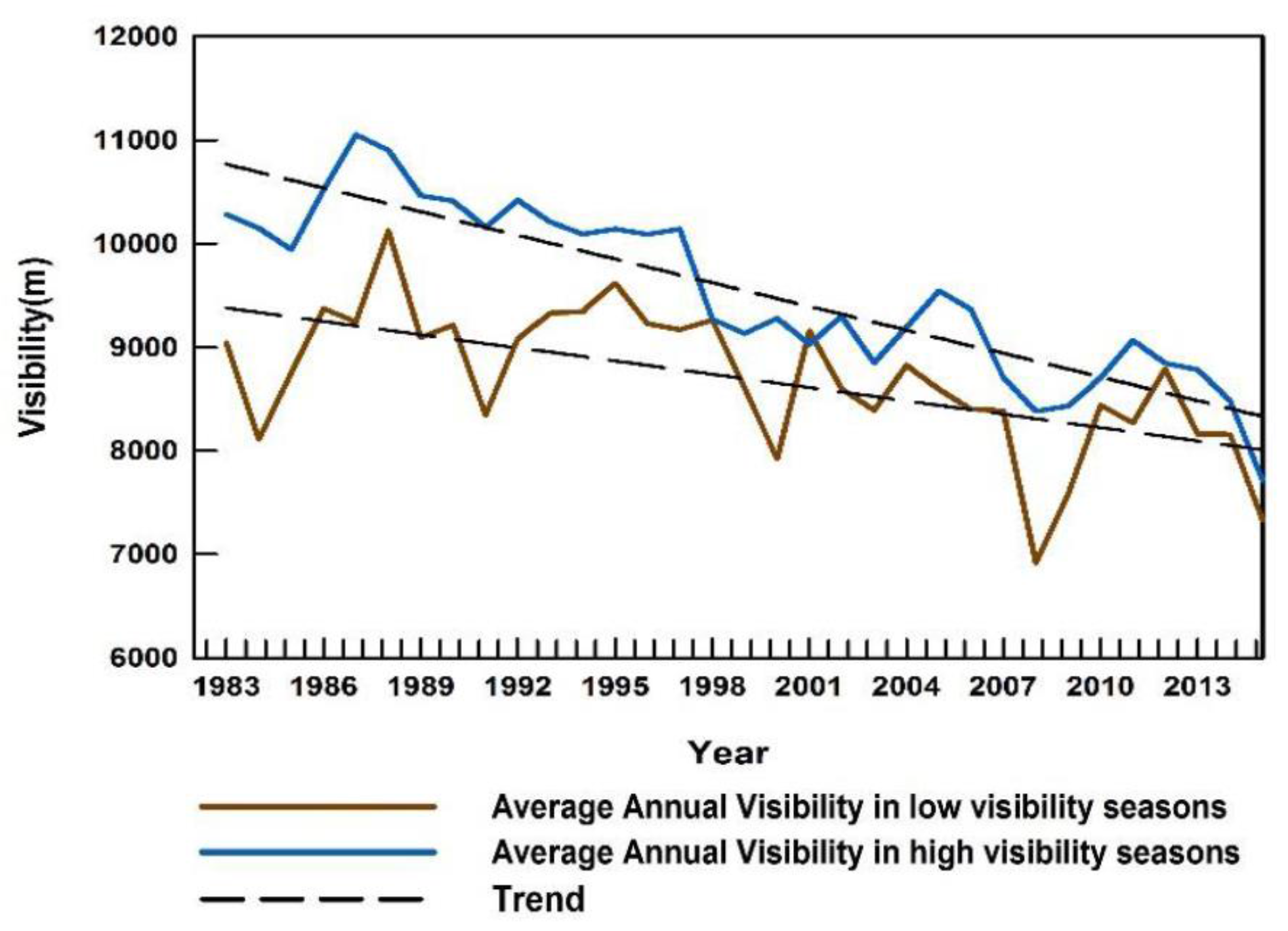
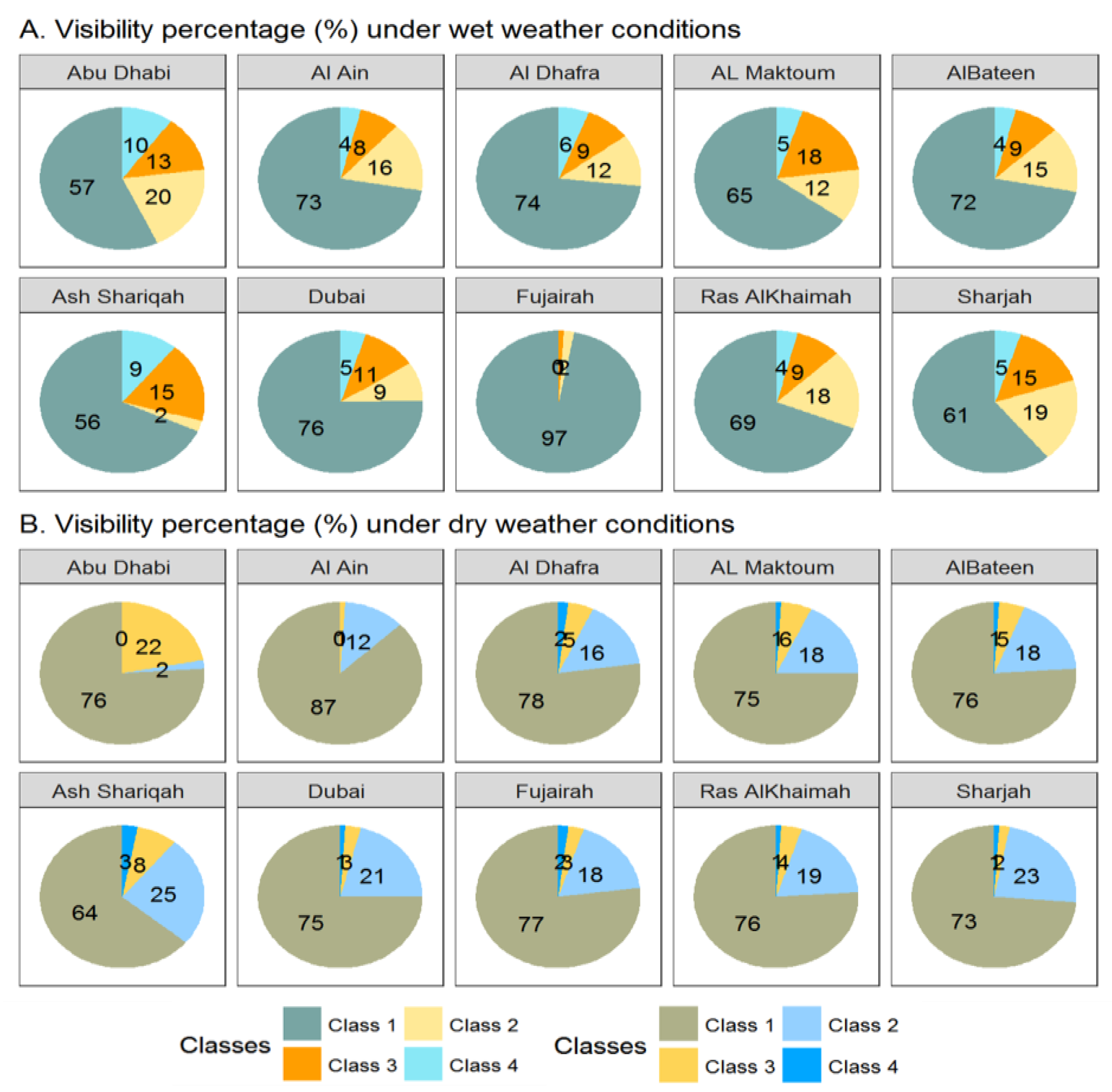

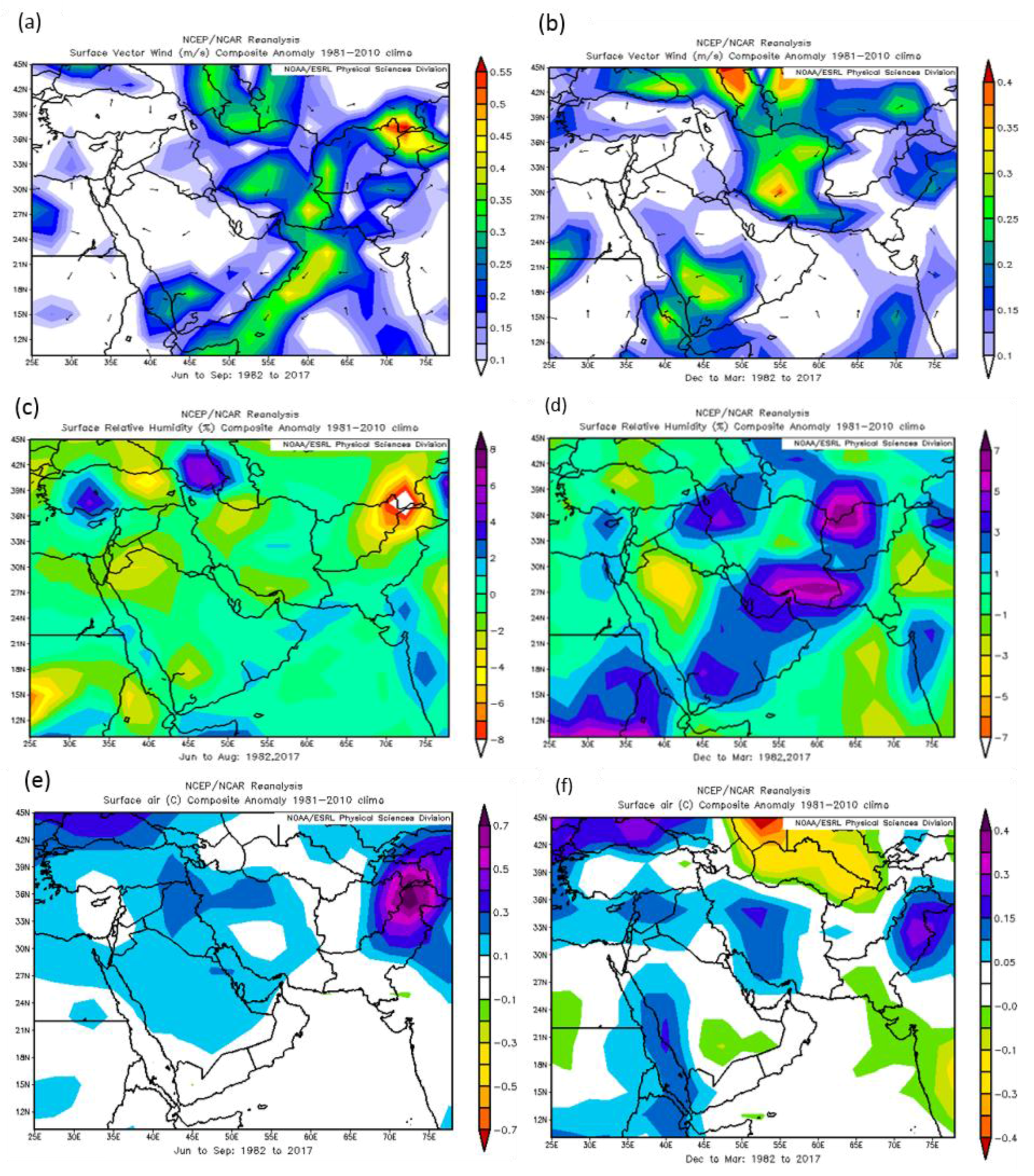
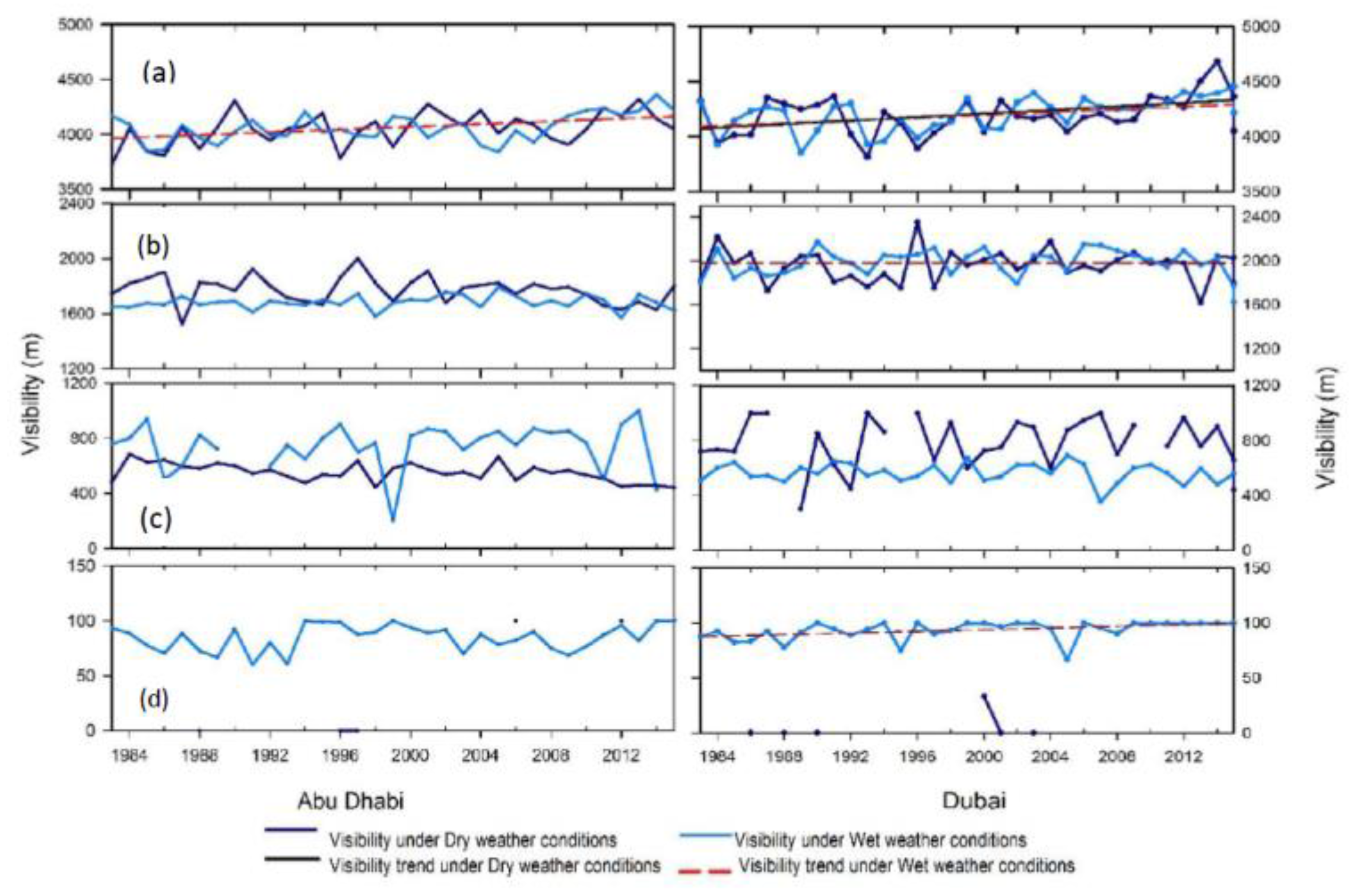
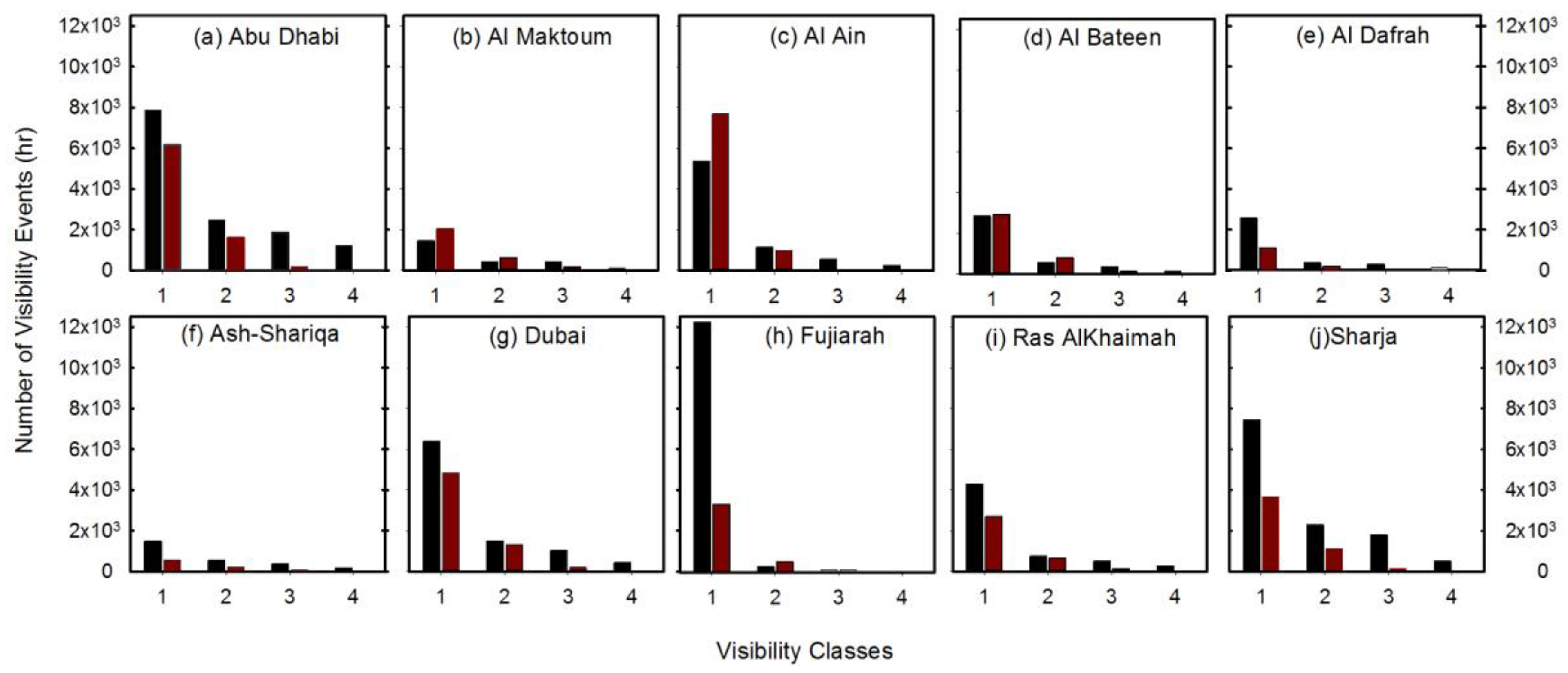




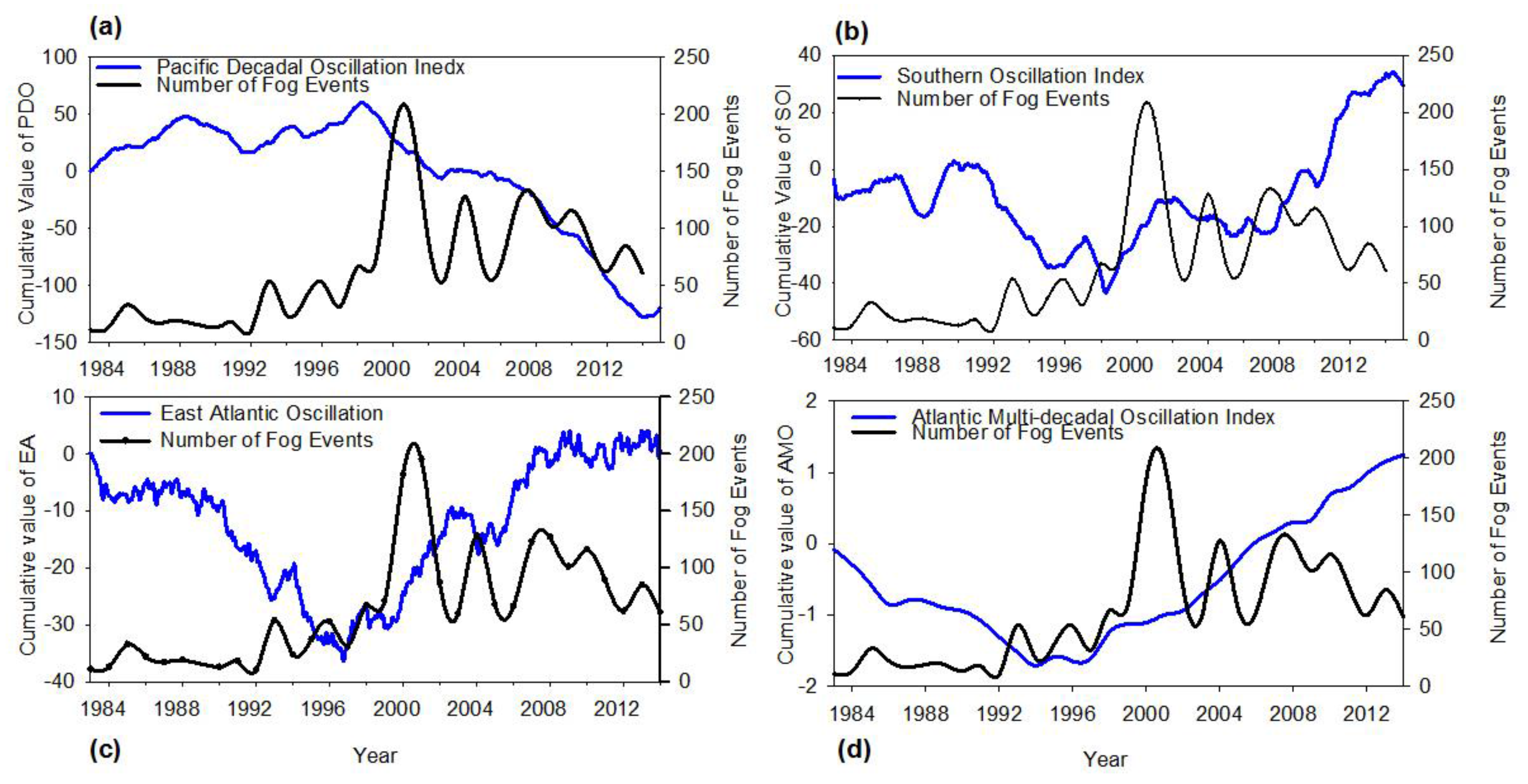


| Station Name | Length of Records | Annual Average Visibility (m) | Standard Deviation (m) | Latitude (N) | Longitude (E) | Elevation (m) |
|---|---|---|---|---|---|---|
| Abu Dhabi IA | 09/1982–03/2016 | 9399 | 3156 | 24.433 | 54.651 | 26.8 |
| AL Maktoum IA | 05/2010–03/2016 | 8355 | 2508 | 24.886 | 55.172 | 18.9 |
| Al Ain IA | 03/1994–03/2016 | 8926 | 2717 | 24.262 | 55.609 | 264.9 |
| AlBateen A. | 01/1983–03/2016 | 9797 | 2594 | 24.428 | 54.458 | 4.9 |
| Al Dhafra A. | 04/1986–03/2015 | 9725 | 2374 | 24.25 | 54.55 | 23 |
| Ash Shariqa IA. | 01/1949–12/1982 | 15,327 | 10,829 | 25.35 | 55.383 | 5 |
| Dubai IA. | 01/1983–03/2016 | 9659 | 3039 | 25.255 | 55.364 | 10.4 |
| Fujairah IA. | 11/1988–03/2016 | 8723 | 2607 | 25.112 | 56.324 | 46.3 |
| Ras AlKhaimah IA. | 01/1983–03/2016 | 9389 | 1806 | 25.613 | 55.939 | 31.1 |
| Sharjah IA. | 03/1944–03/2016 | 10,589 | 5722 | 25.8 | 55.933 | 27 |
| Station Name | Weather Conditions | Visibility Class 1 5.0–2.5 km | Visibility Class 2 2.5–1 km | Visibility Class 3 1–0.1 km | Visibility Class 4 <0.1 km | ||||
|---|---|---|---|---|---|---|---|---|---|
| Average Visibility | Annual Average number of Hourly Events | Average Visibility | Annual Average number of Hourly Events | Average Visibility | Annual Average number of Hourly Events | Average Visibility | Annual Average number of Hourly Events | ||
| Abu Dhabi IA. | Dry | 4.08 | 173 | 1.77 | 49 | 0.55 | 5 | 0.05 | 1 |
| Wet | 4.07 | 221 | 1.69 | 75 | 0.74 | 51 | 0.08 | 38 | |
| AL Maktoum IA. | Dry | 4.30 | 363 | 1.95 | 87 | 0.74 | 29 | 0.10 | 3 |
| Wet | 4.27 | 271 | 1.93 | 52 | 0.48 | 74 | 0.95 | 21 | |
| Al Ain IA. | Dry | 4.34 | 332 | 2.10 | 44 | 0.76 | 3 | 0.02 | 2 |
| Wet | 4.30 | 233 | 2.00 | 50 | 0.52 | 24 | 0.09 | 12 | |
| AlBateen A. | Dry | 4.22 | 114 | 2.05 | 27 | 0.92 | 7 | 0.07 | 1 |
| Wet | 4.35 | 98 | 2.01 | 20 | 0.50 | 12 | 0.09 | 6 | |
| Al Dhafra A. | Dry | 4.20 | 83 | 1.85 | 17 | 0.79 | 5 | 0.06 | 2 |
| Wet | 4.40 | 148 | 1.95 | 23 | 0.48 | 17 | 0.07 | 12 | |
| Ash Shariqa IA. | Dry | 4.10 | 23 | 1.90 | 9 | 0.72 | 3 | 0.05 | 1 |
| Wet | 4.12 | 58 | 1.84 | 21 | 0.57 | 15 | 0.07 | 9 | |
| Dubai IA. | Dry | 4.20 | 146 | 1.96 | 41 | 0.79 | 6 | 0 | 2 |
| Wet | 4.20 | 207 | 1.99 | 24 | 0.56 | 30 | 0.09 | 13 | |
| Fujairah IA. | Dry | 4.30 | 123 | 2.06 | 29 | 0.83 | 5 | 0.08 | 3 |
| Wet | 4.56 | 487 | 2.14 | 11 | 0.63 | 4 | 0.04 | 2 | |
| Ras AlKhaimah AI | Dry | 4.23 | 106 | 1.89 | 27 | 0.79 | 6 | 0.08 | 1 |
| Wet | 4.34 | 171 | 1.85 | 45 | 0.61 | 23 | 0.09 | 9 | |
| Sharjah IA | Dry | 4.12 | 58 | 1.91 | 18 | 0.79 | 2 | 0.04 | 1 |
| Wet | 4.18 | 113 | 1.89 | 35 | 0.54 | 27 | 0.08 | 10 | |
© 2017 by the authors. Licensee MDPI, Basel, Switzerland. This article is an open access article distributed under the terms and conditions of the Creative Commons Attribution (CC BY) license (http://creativecommons.org/licenses/by/4.0/).
Share and Cite
Aldababseh, A.; Temimi, M. Analysis of the Long-Term Variability of Poor Visibility Events in the UAE and the Link with Climate Dynamics. Atmosphere 2017, 8, 242. https://doi.org/10.3390/atmos8120242
Aldababseh A, Temimi M. Analysis of the Long-Term Variability of Poor Visibility Events in the UAE and the Link with Climate Dynamics. Atmosphere. 2017; 8(12):242. https://doi.org/10.3390/atmos8120242
Chicago/Turabian StyleAldababseh, Amal, and Marouane Temimi. 2017. "Analysis of the Long-Term Variability of Poor Visibility Events in the UAE and the Link with Climate Dynamics" Atmosphere 8, no. 12: 242. https://doi.org/10.3390/atmos8120242




